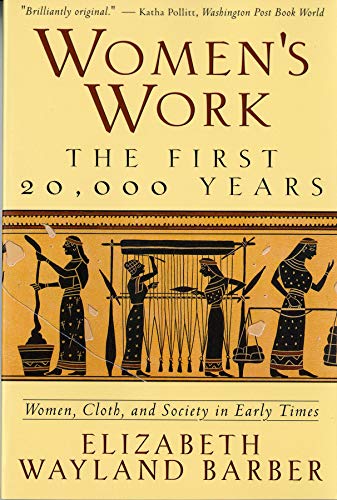Book Review: Women’s Work by Elizabeth Wayland Barber
reviewed by Sukrita Mahon

First published 27 years ago, Women’s Work: The First 20,000 Years: Women, Cloth and Society in Early Times by Elizabeth Wayland Barber is still considered essential reading for contemporary textile artists. Its importance cannot be understated, considering that thread- and cloth-making have been so vital to our civilisation from the very beginning. It’s disturbing to think that since they were the domain of women from the earliest times, they have been left out of much of our histories and archaeological studies. There are a few reasons for this: textiles are much more perishable than other crafts, and until recently we did not have technology to analyse the fibres that did survive. Moreover, they were often not considered worth studying in detail, since most archaeologists were male and not particularly interested in these crafts. Archaeologists who also weave and spin are surprisingly hard to come by even today. Add to this the fact that women usually did not tell their own stories by writing them down (but men did), a lot gets left out.
As a spinner who took it up mainly for fun and stress relief, I found it really interesting to contemplate just how old the craft is. The fact that many of the chapters contain glimpses of the spinners’ and weavers’ lives make it all the more entrancing. I’m sure I’m not the only one who has wondered what the lives of earlier fibre artists might have been like, and the book certainly delivers on building that understanding. I was also struck by how common and all-encompassing a task it was to create cloth: all women participated in it, without exception, nearly constantly! Those who made it their occupation ran workshops that went through huge quantities of wool. Even those who belonged to the ruling classes – princesses and queens – spun and wove, in fact to a high standard, since they were required to make important pieces. Such work couldn’t be delegated away.
Textiles were of pivotal importance to a region’s economy and growth, even before money was invented in its current form. When we think of “treasure” today, we picture gold or jewels, but cloth was among the most prized of possessions. In many places in Asia and elsewhere, this is still true today, as regional textiles still hold a place on the international market. Many regions are famous for their unique handlooms, often passed down within families. Unfortunately, we can no longer say that they are prized as highly as they once might have been, nor that most artisans are able to make a good living from making them. While the book is focused on a small region: Europe, Egypt, and the ancient Near East, we can still imagine how some of the lifestyle aspects may have carried on into present day in areas where these crafts are still practised.
One of the criticisms of the book from other reviewers is that it’s overly academic – I didn’t really find that to be the case. The writing is engaging and the material was very interesting to me. For instance, I had no idea that Venus de Milo is depicted in a spinning stance and that this would have been clear to us if only we hadn’t erased the image of a spinning figure from our collective consciousness. The book does not include very much detail about the spinning or weaving techniques, and the little description there is, I found somewhat confusing. Other craftspeople may not think so, especially those more knowledgeable about weaving than I am.
The detail and intricacy of some of the early textiles is astounding, apparently even to the archaeologists studying them. They wonder why people would go to all that effort to make such beautiful things when, from our point of view, they were merely existing at subsistence level. The author suggests we change our mindset a bit to understand why their textiles were so lavish. In a time with few entertainments outside of the work that needed to be done, any creative impulses would have been cherished and explored to the fullest. Even in this far-away glimpse of an ancient society, we can see similarities with textile villages tucked away in remote parts of the world. People find ways of creative expression through cloth, often regardless of financial circumstance.
I found myself wondering if we had come that far at all in valuing these crafts today. While women have become a lot more independent and are no longer tied to gendered vocations, textile artisans struggle to make a living in many parts of the world. A number of crafts are dying due to globalisation and a shrinking market for the textiles. Women may not have had the opportunity to record their histories in the past, but in the present day, we do have the opportunity to educate ourselves and the wider world about the impacts of colonisation and globalisation on textiles. As spinners or weavers ourselves, we are uniquely positioned, since we have the experience of loving the craft and knowing, sadly, how little it means to people outside of these spheres.
For history lovers and lovers of mythology, there is a lot of inspiration within these pages. Reading about how symbols, colours, and numbers were used to convey various messages struck a deep chord in me. We are still able to imbue our work with meaning and magic in very personal ways. Our ancestors might have woven protective spells into their clothes before embarking on dangerous journeys – and we might do the same today, for very different reasons. The thread of conscious intention, a source of personal power, remains unbroken even today, despite so many attempts to break it. I came away from this book with a renewed sense of reverence for this “women’s work.”
Rating 4/5
PLY Magazine believes that Black lives matter, as well as LBGTQI+ lives. Those most vulnerable and persecuted in our communities deserve our love and support. Please be good to each other.




Leave a Reply
Want to join the discussion?Feel free to contribute!